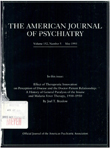Parkinsonism in neuroleptic-naive schizophrenic patients
Abstract
OBJECTIVE: Previous studies in schizophrenia have identified abnormalities involving the basal ganglia, but the contribution of neuroleptics to the motor system abnormalities in schizophrenia is usually a confounding factor. This study addressed the issue of whether parkinsonism, a reflection of dopaminergic hypofunction, occurs in schizophrenia per se. METHOD: Clinical ratings and quantitative instrumental measures of parkinsonian rigidity, tremor, and bradykinesia were obtained in 24 neuroleptic-naive schizophrenic patients and 24 age- and gender-matched comparison subjects. RESULTS: According to the clinical ratings, 21% of the schizophrenic patients had rigidity and 12% had bradykinesia, in contrast to none of the normal comparison subjects. With the use of instrumental measures, rigidity and tremor were observed in 29% and 37%, respectively, of the schizophrenic patients, compared to 4% and none in the normal comparison group. The schizophrenic patients also exhibited greater right-side than left-side parkinsonism. CONCLUSIONS: The findings suggest that extrapyramidal motor signs may be part of schizophrenia proper and that some patients with schizophrenia have left striatal hypodopaminergia unrelated to neuroleptic treatment.
Access content
To read the fulltext, please use one of the options below to sign in or purchase access.- Personal login
- Institutional Login
- Sign in via OpenAthens
- Register for access
-
Please login/register if you wish to pair your device and check access availability.
Not a subscriber?
PsychiatryOnline subscription options offer access to the DSM-5 library, books, journals, CME, and patient resources. This all-in-one virtual library provides psychiatrists and mental health professionals with key resources for diagnosis, treatment, research, and professional development.
Need more help? PsychiatryOnline Customer Service may be reached by emailing [email protected] or by calling 800-368-5777 (in the U.S.) or 703-907-7322 (outside the U.S.).



